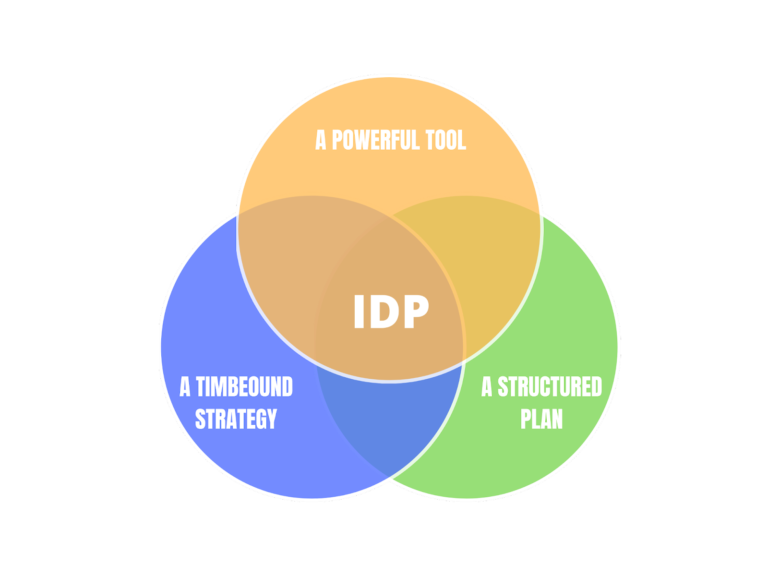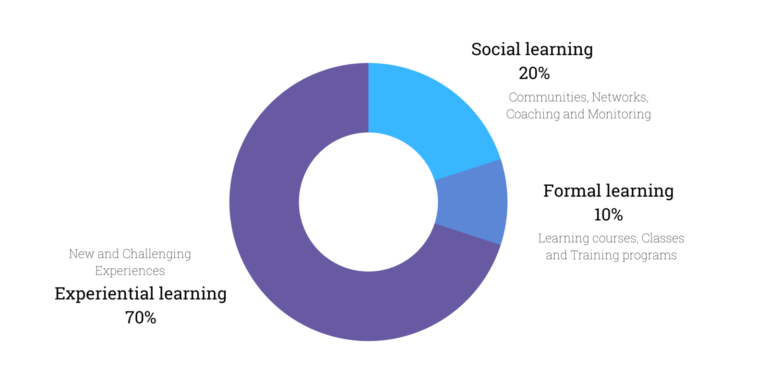According to LinkedIn’s 2018 Workforce Learning Report, a whopping 93% of employees would stay at a company longer if it invested in their career path. A later study from Gallup highlights that Learning new skills ranks as the third most important perk when evaluating job opportunities. In conclusion, Learning and Development is no longer an optional perk or only reserved to key positions.
This is where Individual Development Plans (IDPs) comes into play. In this article, we will study what an IDP is and the key role they play in the retention of the workforce.
What is an IDP?
To put it simply, an Individual Development Plan (IDP) is an action plan that supports competency development. The ultimate objective of an IDP is to assist employees in achieving their career objectives on time.
A powerful tool supporting performance and retention
An IDP does not just point out “what has to be done” to reach career development objectives. Instead, it details “how” to reach development objectives with a succession of learning activities.
An IDP is a comprehensive roadmap that takes into account:
- Which competencies shall be developed to reach career goal(s): What is the current competency level VS expected competency level?
- What must be done: What is the targeted quantified objective that would means this is mission accomplished?
- How to achieve the expected level: What is the action plan to get there?
- Who will be taking part in the evaluation process and monitoring the progress?
- How is progress measured: At which frequency?
A timebound strategy
An IDP must be defined in time, to make sure that talents are reaching the expected career path on time.
As business operations cannot be disrupted because of talent shortage, top management needs to be reassured that the business can survive short-term departures or long-term succession priorities. To achieve this, a talent process must be in place to ensure that a talent can jump on the role in case of resignation, termination, or retirement.
The HR department is accountable for the talent management process. This process aims to make sure that the business has the right talent, at the right place, at the right time.
To do so, large organizations are rolling out time-bound action plans to close gaps between current position requirements, and future career paths positions – to make sure the business has the right supply of talent.
A common case of closing gaps between a current position VS career path is the promotion of an employee to a position of management:
If this employee has never been prepared to managing a team, he/she must become familiar with Performance Management concepts: how to recruit, develop, train and coach others, how to give and receive feedback etc. Therefore, an IDP must be drafted ahead of time
(with on-the-job assignments and learning opportunities) so that the employee can jump into a new role with an operational skillset on time.
A structured plan that mixes formal learning, Mentoring and stretch assignments
What is really inside an IDP? Individual development plans that perform are aligned with the 70:20:10 principle. 70:20:10 is a guideline ratio and highlights that the vast majority of the learning is coming from on-the-job experience. It is also important to understand that varying between the 3 learning types will allow different learning profiles to assimilate competencies – as some people learn better through repetition, others visually, and others through hands-on trial and error.
Stretch Assignments
The most important learning type
(70%)
To develop a competency, employees must be given practical on the job assignments that match their career objective.
Social learning
Learning through others
(20%)
Social learning is about receiving feedback, coaching, or mentoring to improve. Such feedback may come from direct management, peers, direct reports, experts, or even external stakeholders, such as, suppliers and customers.
Active learning
Learning by theory
(10%)
It can be an E-learning class, a podcast, a book, a workshop etc. Although active learning cannot replace learning on the job, it is really important to provide fundamental knowledge and concepts as well as a great source of inspiration to employees. The key is to link active learning with practical on the job assignments
Learn more about 70/20/10 and blended learning here.
Challenges of implementing IDPs
Employee Buy-in over career path
An IDP would not be effective if it is not acknowledged by the employee. To be effective, clear explanation must be provided about the targeted career paths milestones, as well as the priority skills to be developed (skills gaps).
Tip: Share career path objectives transparently during one-on-one. Agree on timelines, competencies development priorities, and the action plan.
Manager commitment
The manager must ensure he/she is allocating time for monitoring, and that assignments provided are really aligned with the development objectives. More often than not, managers need HR support to craft an IDP and needs reminders to follow up on the action plans.
Tips :
- Train managers about the how to draft IDPs
- Install a one-on-one process dedicated to IDP follow up at least once per quarter. Once per month is better.
IDP monitoring outside of the performance management system
IDPs are too frequently created and monitored separately from the current performance management system in place.
There is a way to combine development plans and goal-setting into a single process so that performance supports both the company’s objectives, AND the employee career path’s objectives.
Tips :
- Include competencies as a key component of the performance management system.
- Integrate the action plan into the employee performance objectives
- Set smart objectives and KPIs to measure performance outputs.
Learn more about objectives setting here.
Steps to create a successful IDP program
Every company has their own way of creating IDPs. Here are the main steps:
1. The foundations
Defining the employee’s position (usually part of the job description), as well as its individual goals (annual performance goals).
The company must perform a mapping of each competency required to perform the job, using their own competency framework or by using AI and skills data.
Click here to get started with competency mapping.
2. Identify and focus on skill gaps
Learning resources are scarce, we don’t want to be training an employee on things she/he doesn’t require. Assessing the current skills and knowledge that the employee possesses is key to identifying IDP priorities. This can be done by performing a Competency Review. More skills-driven companies may prefer using a 360 assessment (unbiased evaluation) that may include the employee (self-assessment), its supervisor, peers and/or internal experts.
Click here to get started with competency reviews.
3. Craft the plan
Outline and identify the plans to reach the employee’s career path objectives on time. We recommend balancing the plan activities according to the 70-20-10 principle.
4. Smooth execution
Implementing the aforementioned plans by training and development. Many organizations tend to rely solely on HR to monitor and execute. That is a mistake. Managers MUST be involved during the year to make sure all components of the IDP of their team is on track.
5. Evaluate the result and iterate!
Performance reviews usually allow measuring if skills gaps are being addressed as intended. To get accurate feedback on competency development plans and gaps to be addressed, it is recommended to perform 360-degree assessments at regular intervals to keep track of the results.





